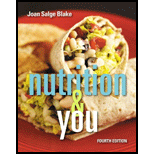
Concept explainers
To examine: Whether the statement “There isn't any risk to over-consuming the essential nutrients in your diet” is true or false.
Introduction: Human body requires nutrients to drive the overall biological activities. There are some nutrients that are essential for the human body found in various foods. The essential nutrients are carbohydrates, fats, proteins, vitamins, and minerals. They play a vital function in the human growth and development.
Answer to Problem 1TF
Correct answer: The statement is false.
Explanation of Solution
The food and nutrition board recommends the “Dietary Reference Intake (DRI)” that includes the amount of essential nutrients that are required daily to prevent the deficiency of essential nutrients and thereby promote good health. The nutrient requirement of the person is changed according to an individual’s age and gender. Too much consumption of essential nutrients can be harmful because the threshold intake level for every nutrient is decided by DRI. For example, too much intake of fat will increase the level of cholesterol and leads to risk of heart disease and stroke in the body which is harmful.
Hence, the statement is false.
Want to see more full solutions like this?
- Which of the following statements is not true? a. Essential nutrients can be synthesized by the body. b. Vitamins are required in small quantities for bodily function. c. Some amino acids can be synthesized by the body, while others need to be obtained from diet. d. Vitamins come in two categories: fat-soluble and water-soluble.arrow_forwardDifferent regions of the digestive system specialize in ________ and _________ food and in __________ unabsorbed food residues.arrow_forwardThe food label in Figure 11.28 lists the nutrients and other substances in a package of ready-to-eat macaroni and cheese. Based on your reading in this chapter, how would you rate this products healthiness in terms of fats and carbohydrates? Figure 11.28 Food labels are useful health tools. Information on a food label can be used to ensure that you get the nutrients you need without exceeding recommended limits on less healthy substances such as salt, sugar, and trans fats. At present, the USDA is considering major revisions to food labels. The proposed changes include showing realistic serving sizes and sugars added by the manufacturer, and printing the calorie content per serving in larger, bolder type so that it is easier for consumers to make informed choices about purchases of prepared foods. (Left: USDA, US Department of Agriculture; Right: FoodCollection/SuperStock)arrow_forward
 Nutrition Through The Life CycleHealth & NutritionISBN:9781337919333Author:Brown, Judith E.Publisher:Cengage Learning,
Nutrition Through The Life CycleHealth & NutritionISBN:9781337919333Author:Brown, Judith E.Publisher:Cengage Learning, Human Biology (MindTap Course List)BiologyISBN:9781305112100Author:Cecie Starr, Beverly McMillanPublisher:Cengage Learning
Human Biology (MindTap Course List)BiologyISBN:9781305112100Author:Cecie Starr, Beverly McMillanPublisher:Cengage Learning NutritionHealth & NutritionISBN:9781337906371Author:Sizer, Frances Sienkiewicz., WHITNEY, ElliePublisher:Cengage Learning,
NutritionHealth & NutritionISBN:9781337906371Author:Sizer, Frances Sienkiewicz., WHITNEY, ElliePublisher:Cengage Learning,





